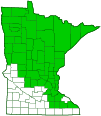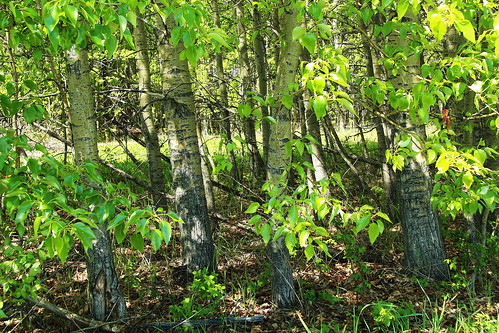balsam poplar
(Populus balsamifera)
Conservation • Wetland • Description • Habitat • Ecology • Use • Distribution • Taxonomy
Conservation Status |
|
|||||||
| IUCN Red List | not listed |
|||||||
| NatureServe | N5 - Secure SNR - Unranked |
|||||||
| Minnesota | not listed |
|||||||
Wetland Indicator Status |
||||||||
| Great Plains | FACW - Facultative wetland |
|||||||
| Midwest | FACW - Facultative wetland |
|||||||
| Northcentral & Northeast | FACW - Facultative wetland |
|||||||
Description |
||
Balsam poplar is a medium-sized to large, fast-growing, short-lived, deciduous tree with a single trunk. It is often the largest tree in a stand of trees. In areas with periodic flooding a new root system is produced after a flood. Roots develop at the newly-submerged base of the trunk in the recently deposited soil. The result is a multilayered root system. On wet sites not prone to flooding the roots are shallow and wide spreading and the trees are prone to windthrow. The tree also produces root suckers and is sometimes colonial, especially in dryer areas. In Minnesota mature trees are usually 40′ to 70′ tall and 4 ″ to 20″ in diameter at breast height, though large individuals can reach over 80′ in height and 24 ″ in diameter. Young trees have a clearly defined bole, with the trunk is distinct to near the top of the crown. The crown on young trees is cone-shaped. On older trees the the trunk divides at the top into two or more equally dominant, ascending, major branches. Other branches are relatively short and ascending. The crown on older trees is rounded. The bark on young trees is somewhat smooth, greenish-brown to greenish-gray, and sometimes tinged with red. It has numerous raised, diamond-shaped, lighter colored bumps (lenticels). The lenticels eventually become vertical cracks. As it ages the bark becomes thick and darker gray or grayish-brown. On the lower trunk the vertical cracks develop onto deep, narrow, V-shaped furrows between flat-topped ridges. First-year twigs greenish and hairy. Second-year twigs are reddish-brown, shiny, and hairless or hairy, with bright orange lenticels. Third-year twigs are moderately stout, grayish-brown, and round in cross section. A cut twig shows a solid, star-shaped core of spongy cells (pith) and has a bitter aspirin taste. The bud at the end of the twig (terminal bud) is reddish-brown, hairless, egg-shaped, round in cross section, and ⅝″ to ¾″ long. It is widest near the base and tapers to a sharp point at the tip. It is covered with 5 overlapping scales, is sealed with a red, sticky resin, and has a strong balsamic fragrance. Lateral buds are similar but narrower. They are appressed to the twig for most of their length but free at the tip. The first (lowest) scale is directly above the leaf scar. The leaf scars are nearly triangular and have 3 bundle scars. They are straight across at the top, not indented. There is no eyelash-like fringe of hairs where the bud meets the scar. Two types of leaves are produced: early (preformed) leaves; and late (neoformed) leaves. Early leaves overwinter in the bud and are fully formed or almost fully formed before the buds burst in the spring. They are the first leaves to mature in the spring. Neoformed leaves are all of the subsequent leaves produced on long shoots. They are formed in the same season that they emerge. All leaves are deciduous, alternate, and not lobed or divided (simple). They hang downward on yellowish, minutely hairy, flattened, ⅝″ to 2″ long leaf stalks (petioles). The petioles are round in cross section but may have a shallow channel on the dorsal (upper) surface. There are usually 0 or 2, rarely up to 5, warty glands at the point where the leaf blade attaches to the petiole. The leaf blades are egg-shaped to narrowly egg-shaped, 2″ to 3½″ long and 1¼″ to 2¼″ wide. They are 1.2 to 2.3 times as long as wide. They taper to a point at the tip with straight sides along the tip. Sometimes the tip is slightly extended with concave sides along the very tip. They are rounded or slightly heart-shaped at the base. The upper surface is dark green, shiny, and hairless. The lower surface is pale green, covered with a whitish, waxy coating, and hairless. There are usually some reddish-orange (copper-colored) resin stains on the lower surface. The margins of early leaves appear almost untoothed or are shallowly toothed with usually 20 to 35 teeth per side. The teeth are rounded, forward pointing, and distinctly curved. The margins of late leaves are similar but with deeper teeth and usually 30 to 45 teeth per side. The leaves turn yellow In autumn. Male and female flowers are borne on separate trees. They appear before the leaves in early May to early June. Both male and female flowers are borne in crowded, pendulous, short-stalked or almost stalkless clusters (catkins) of usually 50 to 70 flowers. The catkins emerge from lateral buds on 2nd year twigs. Male catkins are 1½″ to 3½″ long, stout, and densely flowered. Each male flower has 20 to 30 stamens with anthers that are bright red before shedding pollen. Female catkins are 2⅜″ to 6¼″ long. The central axis (rachis) of the catkin is densely covered with short hairs. Female catkins elongate when fruiting, becoming 3½″ to 6¾″ long. The fruit is an egg-shaped, ¼″ to ⅜″ long, 2-valved capsule. Each capsule contains 30 to 44 seeds. The seeds are released in late May to June. They have cottony hairs attached and are dispersed by wind. |
||
Height |
||
40″ to 70″ |
||
Record |
||
The champion balsam poplar in Minnesota is on private property near Waskish, in Beltrami County. In 2019 it was measured at 87′ tall and 129″ in circumference (41″ in diameter), with a crown spread of 123′. |
||
Flower Color |
||
Yellowish-green |
||
Similar Species |
||
Plains cottonwood (Populus deltoides ssp. molinifera) petioles are conspicuously flattened. The leaves are broadly triangular in shape and proportionately wider. They are no more than one third as long as wide. The base of the leaf blade is squared off. The leaf underside is not stained with copper-colored blotches. The buds are not aromatic. The rachis of the catkin is hairless. Quaking aspen (Populus tremuloides) leaves are proportionately wider. The petioles are conspicuously flattened. Male flowers have 40 to 80 stamens. Female catkins are no more than 2⅜″ long. |
||
Habitat |
||
Moist. Boreal forests, aspen parklands, lakeshores, riverbanks, swamp margins, marsh edges. Full or partial sun. Very shade intolerant. |
||
Ecology |
||
Flowering |
||
Early May to early June |
||
Pests and Diseases |
||
Pemphigus populicaulis (no common name) is an aphid that causes a gall at the junction of leaf blade and petiole. The opening in the gall is a slit running parallel to the direction of the petiole. |
||
Use |
||
The inner bark contains salacin, a precursor of aspirin. |
||
Distribution |
||||
|
Sources |
|||
| 2/17/2023 | ||||
Nativity |
||||
Native |
||||
Occurrence |
||||
Common in northern and central Minnesota, uncommon in the southeast, absent from the southwest. |
||||
Taxonomy |
|||
| Kingdom | Plantae (Plants) | ||
| Subkingdom | Pteridobiotina | ||
| Phylum | Tracheophyta (Vascular Plants) | ||
| Class | Magnoliopsida (Dicots) | ||
Order |
Malpighiales (Nances, Willows, and Allies) | ||
Family |
Salicaceae (Willow) | ||
| Subfamily | Salicoideae | ||
| Tribe | Saliceae | ||
| Genus | Populus (poplars, cottonwoods, and aspens) | ||
| Section | Tacamahaca | ||
Synonyms |
|||
Populus balsamifera ssp. balsamifera Populus balsamifera var. candicans Populus balsamifera var. fernaldiana Populus balsamifera var. lanceolata Populus balsamifera var. michauxii Populus balsamifera var. subcordata Populus candicans Populus michauxii Populus tacamahaca Populus tacamahaca var. candicans Populus tacamahaca var. lanceolata Populus tacamahaca var. michauxii |
|||
Common Names |
|||
balm of Gilead balsam poplar bamtree eastern balsam poplar hackmatack Ontario balsam poplar tacamahac poplar tacamahaca |
|||
Glossary
Bundle scar
Tiny raised area within a leaf scar, formed from the broken end of a vascular bundle.
Catkin
A slim, cylindrical, drooping cluster of many flowers. The flowers have no petals and are either male or female but not both.
Lenticel
A corky, round or stripe-like, usually raised, pore-like opening in bark that allows for gas exchange.
Petiole
On plants: The stalk of a leaf blade or a compound leaf that attaches it to the stem. On ants and wasps: The constricted first one or two segments of the rear part of the body.
Pith
The spongy cells in the center of the stem.
Rachis
The main axis of a compound leaf, appearing as an extension of the leaf stalk; the main axis of an inflorescence.
Simple leaf
A leaf that is not divided into leaflets, though it may be deeply lobed or cleft.
Sucker
A basal shoot rising from the roots or from a bud at the base of a shrub or tree.
Visitor Photos |
|||||
Share your photo of this plant. |
|||||
| This button not working for you? Simply email us at info@MinnesotaSeasons.com. Attach one or more photos and, if you like, a caption. |
|||||
|
|||||
MinnesotaSeasons.com Photos |
|||||
|
|||||

Visitor Videos |
|||
Share your video of this plant. |
|||
| This button not working for you? Simply email us at info@MinnesotaSeasons.com. Attach a video, a YouTube link, or a cloud storage link. |
|||
Other Videos |
|||
| Balm Of Gilead Cottonwood Buds Habitat Wild Medicinals MiWilderness |
|||
About
Uploaded on Feb 11, 2012 Balm of Gilead is a wild medicinal that is harvested from the buds of Cottonwood and Balsam poplar. Part one of this series shows the habitats where it is typically found. Part two: http://youtu.be/KGEt0dzYT4w Wild medicinals playlist: http://www.youtube.com/playlist?list=PL81021CE944A71DDF |
|||

Visitor Sightings |
|||||
Report a sighting of this plant. |
|||||
| This button not working for you? Simply email us at info@MinnesotaSeasons.com. Be sure to include a location. |
|||||
|
|||||
MinnesotaSeasons.com Sightings |
|||||

|
Created: Last Updated: © MinnesotaSeasons.com. All rights reserved. |



